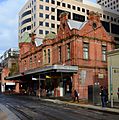George McRae facts for kids
Quick facts for kids
George McRae
|
|
|---|---|

George McRae, around 1890
|
|
| Born | 10 September 1857 |
| Died | 16 June 1923 (aged 64) Sydney, New South Wales, Australia
|
| Nationality | Scottish Australian |
| Occupation | Architect |
| Spouse(s) | Katie Prescott |
| Practice | NSW Government Architect |
| Buildings |
|
George McRae (born September 10, 1857 – died June 16, 1923) was a famous architect. He was born in Edinburgh, Scotland, and later moved to Sydney, Australia. In Sydney, he became the Government Architect for New South Wales. He designed many of Sydney's most well-known buildings. These include finishing the Sydney Town Hall, creating the Queen Victoria Building, and designing the main entrance to Taronga Zoo.
Contents
George McRae: Architect of Sydney's Landmarks
Early Life and Career
George McRae was born in Edinburgh, Scotland, in 1857. His father, Duncan, was a joiner, and his mother was Mary. In 1884, George moved to Sydney, Australia. He started working as an Assistant Architect for the City Architect's office.
By 1889, he became the City Architect and City Building Surveyor. He held this important job until 1897. After that, he became the main assistant to Walter Liberty Vernon in the Government Architect's team. In 1912, George McRae took over from Vernon. He became the New South Wales Government Architect. He kept this role until he passed away in 1923.
George McRae married Katie Prescott on May 8, 1895. Their wedding took place at St Mark's church in Darling Point.
Designing Famous Buildings
George McRae designed many buildings in Sydney and other places. A lot of his buildings are still standing today. Some of them are even protected as important historical sites.
When he was the Government Architect, McRae worked on several key projects. These included the Education Department Building in 1912 and the Parcels Post Office in 1913. He also designed the lower and top entrances, and the Indian elephant house at Taronga Zoo. He added to the Colonial Treasury Building in Bridge Street. He also designed the Court House in Cessnock.
Key Projects by McRae
Here are some of the important buildings George McRae designed:
- Rozelle Tram Depot (1904): Located in Glebe, New South Wales. This building had a special roof design hidden by brick walls.
- Department of Education building (1912): Found on Bridge Street in Sydney. This six-story building is made of sandstone. It has a strong steel and concrete structure inside.
- Model factory and dwelling, The Rocks (1912–1913): Located at 120 Gloucester Street. This project replaced old, crowded homes. It showed new ideas about creating better living spaces.
- Former Parcels Post Office (1913): Located at Railway Square in Sydney. This brick and sandstone building was very well designed. It used to be a post office and a place for telex machines. Today, it has been restored and is a hotel.
- Taronga Zoo Entrances and Elephant House (1916): Located in Mosman, Sydney. McRae designed the lower entrance, top entrance, and the Indian elephant house. These were part of the new zoo, which replaced an older one.
- Corporation Building (around 1893): Located on Hay Street, Sydney. This building was first called the Municipal Building. It mixed different architectural styles. It originally had market stalls on the ground floor.
- Additions to the Colonial Treasury Building (around 1896): Located on Bridge Street, Sydney. McRae added to this building, which was first built around 1849.
- Queen Victoria Building (1893–1898): Located on George Street, Sydney. This beautiful sandstone building is a masterpiece. It was reopened in 1986 as a shopping center after a big restoration.
- Former Sydney City Markets (1910): Located on Ultimo Road in Haymarket. This was part of a larger market area. It was later turned into a hotel.
- Corn Exchange (1887): Located on Sussex Street, Sydney. This building was built by the City Council. It has a unique curved front.
- Court House, Cessnock (built after 1905): Located on Maitland Street in Cessnock, New South Wales. This building helped make Cessnock an important center for the coal fields.
- St James railway station: This important railway station in Sydney is also listed on the New South Wales State Heritage Register.
- In 1916, he also began work on the Wilson Memorial Community Hospital.
Later Life
George McRae's funeral was held on June 18, 1923. It took place at Rookwood Cemetery. Many people from government departments attended to pay their respects. He was survived by his wife, his son, and his two daughters.
Images for kids
-
Cessnock Court House.
-
Queen Victoria Building with Sydney's former tram service in view, c. 1920.
-
Department of Education building, Bridge Street, Sydney.
-
Former City Markets building, Ultimo Street, Haymarket.
-
Former Parcel Post Office, Railway Square, Sydney.
-
Leeton Courthouse, completed in 1943 in the Interwar Stripped Classical style.
-
Corporation Building, 181-187 Hay Street, Sydney.









